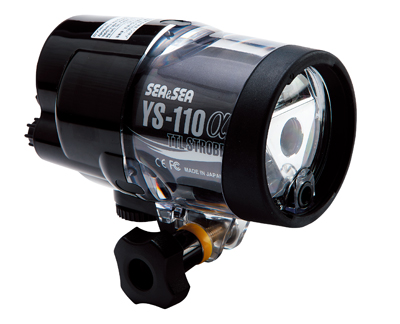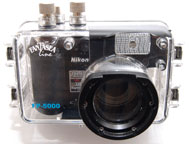Choosing an Underwater Strobe for Point & Shoot Cameras

Jack,
I have a Fuji E900 and Ikelite housing. What strobe would you suggest for this set-up and what price range am I looking at? I would appreciate your help.
Thanks,
Laurel
The E900 is a great little camera, I shot mine for 1.5 years with good results. I get asked this same question by many underwater photographers looking for an external strobe to use with various cameras. The below information is derived from my experience and pertains to most point & shoot cameras and housings.
An external strobe is a way for photographers to add more light to bring out colors and detail that would otherwise be lost and creatively light their subjects, to emphasize, or de-emphasize subject matter. Also by angling the light away from the subject directly, you can you can reduce backscatter; particles in the water that reflect light directly into the camera lens.
When buying a strobe, you pretty much get what you pay for in terms of features, power, coverage and speed. It's important to consider what subject matter and shooting conditions you will be diving in. Wide angle photography requires much more powerful strobes, really 2 strobes, for success. You have to light a wide swath of reef or larger subjects. For macro and fish portraits, you can get by with much less. In turbid conditions the same applies. I'm making some generalizations; it is quite possible to do close-focus wide angle photography and use only one strobe. It's good to also consider your long-range photography goals as well; if you eventually want to upgrade to a DSLR for instance.
There's lots of manufactures and options for strobes. Remember that you will also need a tray, handles, arms and sync cord to use it. Here's a few that I'm familiar with.
I've used a variety of Inon strobes, they are very good, physically small, but sort of expensive. They also tend to be a bit negatively weighted in the water. The Inon z240 & 2000 have S-TTL and an external auto mode (works ok for close-up stuff), as well as 13 steps of manual control. The S-TTL mode will work with most any camera, measuring the light output automatically, but as it makes the camera do a full dump of light (instead of what's necessary for exposure), it can be slow to use, around 11 secs between shots on the E900!
I've used an Ikelite DS-51 with an external manual controller as well (the auto TTL controller is not compatible with the E900). Again, its very slow to work with that camera, due to making it do a full dump. It was better with the Fuji F810. I had problems with the manual controller flooding and it's another piece of gear to mount and swim with, although a fairly powerful little strobe. I think overall the setup is bulky and not as full featured, when compared to other strobes on the market at a similar price point.
The Ikelite DS-160 is a great wide angle TTL strobe when used with their housings, with a Nikon TTL converter, or in manual with other housings. It has a nice warm cast to it and plenty of power. It has a rechargeable battery, but the charger is sold separately.I don't recommend the DS-161 Movie strobe, as the internal video light is quite weak and uneven. A separate video light is much more powerful.
Ikelite has come out with a Fiber Optic Converter that works with their strobes, but it only works in manual mode.
 I sell the Fantasea NanoFlash ($99), the best-selling Sea & Sea YS-01 ($429) and the Sea & Sea YS-110a ($634). If you want a huge reef-lighter the Sea & Sea YS-250Pro is also available at $1069.
I sell the Fantasea NanoFlash ($99), the best-selling Sea & Sea YS-01 ($429) and the Sea & Sea YS-110a ($634). If you want a huge reef-lighter the Sea & Sea YS-250Pro is also available at $1069.The Fantasea NanoFlash is a small starter strobe. It's pretty good in clearer waters for macro, or close-in fish portrait photography. It is very small and light, making it easy to swim with. But it's not suitable for wide angle photos, or "lighting up the reef".
The Sea & Sea YS-01 is probably my most popular strobe. It has a guide number of about 20, a wide 100x100 beam angle, targeting light and TTL. It also has 10 steps of manual adjustment. There is also the YS-02 that is the same stobe, but without the TTL or targeting light, and it sells for $109 less.
With most M4/3rds or DSLR cameras, I'd recommend any of the Sea & Sea strobes, leaning toward the YS-110a. It is more powerful at a guide number of 22, has a wider beam angle, and has 13 steps of manual control. It also has a target light, and can be used with a DSLR that has electrical sync should you upgrade in the future.
 It does have a D-TTL mode (like Inon's S-TTL) that works with most cameras, depending if it uses multiple pre-flashes or single. However some cameras, notably the Olympus XZ-1, and the Nikon D7000 do not work in TTL mode with Sea & Sea D-TTL. I do think they much easier to use with gloves than the Inons, as the knobs are a bit larger, and there's less knobs to deal with to operate it. They are considerably cheaper than the Inon strobes, and tend to be lighter in the water.
It does have a D-TTL mode (like Inon's S-TTL) that works with most cameras, depending if it uses multiple pre-flashes or single. However some cameras, notably the Olympus XZ-1, and the Nikon D7000 do not work in TTL mode with Sea & Sea D-TTL. I do think they much easier to use with gloves than the Inons, as the knobs are a bit larger, and there's less knobs to deal with to operate it. They are considerably cheaper than the Inon strobes, and tend to be lighter in the water. All of these strobes work with a fiber optic sync cord, with one end of the cord velcroed on the outside of the camera housing and the other plugged into the light sensor of the strobe. You should black out the camera's internal flash on the inside of the housing with some electrical tape, except for a small area under the connector to trigger the external strobe. This will reduce backscatter and let you control the light.
All of these strobes work with a fiber optic sync cord, with one end of the cord velcroed on the outside of the camera housing and the other plugged into the light sensor of the strobe. You should black out the camera's internal flash on the inside of the housing with some electrical tape, except for a small area under the connector to trigger the external strobe. This will reduce backscatter and let you control the light.To control backscatter, you have to have your strobes pointed away from your subject and use only the edge of the light to light it. Basically you have the lights pointing forward and away from the center. This allows the light to reflect away from the camera lens for particulates in the water column.
 A focus light is very necessary for you to see to frame and your camera to lock auto focus. They are particularly convenient for night diving. Many users are also including video lighting or a more powerful focus/video light in the systems, like the new iTorch Pro-mini.
A focus light is very necessary for you to see to frame and your camera to lock auto focus. They are particularly convenient for night diving. Many users are also including video lighting or a more powerful focus/video light in the systems, like the new iTorch Pro-mini.We sell all of these strobes in various lighting packages of trays, arms, handles, sync cord and choices of focus lights on my website at reasonable prices. The Optical Ocean packages are modular and work with most any housing; you can add different components to each package to customize to your desires. I especially like the Wide S-Tray that adjusts in and out to fit various sized-hands and housings. It can be configured for either ball & joint or flex arms.
Another low-cost option is to consider using a red filter on the port of your housing, it will reduce the cyan cast and give a much more natural color, especially when used with manual white balance.
Please also see our free guide "Basic Principles of Strobe Positioning" for more information.
(This article has been updated as of 1/12).














Wow! Just came across your blog - what an abundance of great information!! Keep up the good work!!
=)
_ndg
Posted by Neutral Dive Gear |
9:28 PM
Neutral Dive Gear |
9:28 PM
Good information, Jack. Thanks!
Posted by Anonymous |
11:53 AM
Anonymous |
11:53 AM
Jack...i tried to do as you posted, but blacking out the flash with an electrical tape...guess what?...now the flash seems burned...i took the tape off...tried a couple of flashes...it still smells burnt even though the flash is not blacked out totally...guess i damaged my NIKON P5100 by following your tip...
Posted by seejork |
8:49 AM
seejork |
8:49 AM
You should black out the camera's internal flash on the inside of the housing with some electrical tape, except for a small area under the connector to trigger the external strobe. This will reduce backscatter and let you control the light.
With reference to your tip above, I did exactly as you suggested and guess what??...it burned my built-in flash...not completely, but you can smell something burned whenever using the flash...I guess that tip damaged my Nikon P5100 camera...what a bummer
Posted by seejork |
9:00 AM
seejork |
9:00 AM
seejork;
Apparently you mis-understood my tip. You should put tape on the housing, _Not_ the camera's flash. Of course heat there would build up.
We've taped over the insides of dozens of housings without any issue whatsoever.
Posted by Jack |
11:14 AM
Jack |
11:14 AM
instead of taping it, i painted the inside of the housing all black except for the part where the built-in flash peaks from..oh and by the way, the camera is working perfect now..i managed to scrub away the residue left by the electrical tape which causes it to burn..can't wait to try it and see the results.
Posted by seejork |
2:12 AM
seejork |
2:12 AM
Any word on the new Fantasea Remora Strobe? It's around $189 USD with a guide# of 20 (ISO 100 in Air).
I'm interested in this one for the 4 different preflash settings; I can use my camera in manual and program exposure modes.
I see the online Photogear websites are taking orders now.
Posted by retiredman2006 |
11:49 PM
retiredman2006 |
11:49 PM
This comment has been removed by the author.
Posted by Jack |
11:49 PM
Jack |
11:49 PM
The new Fantasea Remora is $198 and available in my store later this week. It is about the same power as the UltraMax, but has a nice diffuser and much more adjustable power. It lacks a sealed battery compartment. Although it has 4 pre-flash settings, so does the Ultramax, actually it has 5. Pre-flash settings are just that, they have nothing to do with camera modes.
Posted by Jack |
11:51 PM
Jack |
11:51 PM